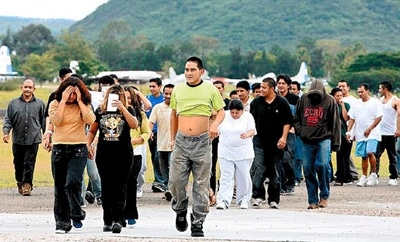The United States has stated that for 2012 it will only send Honduran deportees, half of whom have criminal records, back to the region’s most violent city, San Pedro Sula, a decision which could place returning migrants at further risk of being targeted by the country’s maras for recruitment.
As of September 13, Honduras nationals deported from the United States back to their home country will, for the remainder of the year at least, no longer be sent to Toncontin International Airport in the capital Tegucigalpa.
“The US Embassy confirmed this week that all deportation flights coming from the US will now go to [the northwest city of] San Pedro Sula,” announced Sister Valdette Willeman, director of the Service Center for Returned Migrants (CAMR).
Deportation flights had previously been split between the two cities.
According to La Prensa, circumstances surrounding the US’s decision remain unclear, though Wileman stated her belief that it is related to the fact that a flight containing deportees was unable to land at Toncontin on 20 August.
The US Department of Homeland Security released figures earlier this month showing that, in 2011, 21,963 Hondurans were deported back to their home country, of whom nearly half (10,801) had prior criminal convictions. Though this number has been on the decline in recent years — the DHS figure for 2009 was over 27,000 — it appears to be rising once again. The CAMR stated last month that between January and August this year, 22,000 Hondurans were deported, a jump of 36 percent compared to the same period in 2011.
InSight Crime Analysis
The decision to send all deportation flights to San Pedro Sula is worrying. Earlier this year the city was handed the unfortunate title of most dangerous in the Western Hemisphere with a homicide rate of 159 per 100,000 inhabitants, nearly double the national rate of 82.1 per 100,000, in itself one of hte highest in the world. What’s more, it is a hotbed of activity for the country’s street gangs, or “maras.” An estimated 1,344 members of the MS-13 are currently battling some 1,242 Barrio 18 members for control of the city’s extortion rackets and local drug networks. These numbers are nearly three times those seen in Tegucigalpa.
Deportees returned to this environment, one that isn’t necessarily their home, “prove excellent recruits for crime syndicates, cartels, and gangs,” notes Honduras Weekly. This is exacerbated further by the fact that almost half of the returnees have a criminal history. Since the 2009 coup, the Honduran economy has been faltering, with the unemployment rate hovering around the 50 percent mark. With a background in criminal activity, the prospect of joining a mara is a far more likely prospect than getting a job.
The CAMR actively works to transport the returning migrants back to their places of origin, but with the number of returnees increasing, it remains to be seen whether they have the resources to effectively cope with the deportees.
This latest decision by the US shines a light on their deportation policy as a whole in the region and its implications for organized crime. A recent Los Angeles Times article outlined how the policy of sending Mexican migrants to the state of Tamaulipas, where many had no familial connections, was driving gang activity in the area. Gunmen reportedly would wait for the deportees to arrive, then kidnap them for ransom — since they are viewed as comparatively wealthy — or recruit them into gangs. A Roman Catholic priest who oversee migrant shelters in the region told the newspaper, “deporting people here is like sending them into a trap.”
The US did announce in February that it would change its deportation policy by flying migrants back to their place of origin in an effort to combat forced recruitment and kidnapping. So far however, this policy has failed to take effect in Mexico and there has been little or no intimation that it would be extended throughout the region, meaning deportees thrown into unfamiliar and often dangerous surroundings, will continue to remain targets for Central American gangs.

